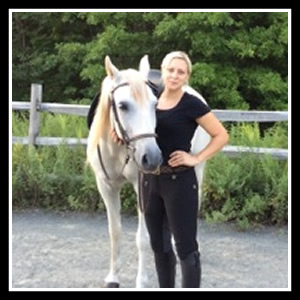Keeping the back engaged in the working gaits

Today we are going to give you another example of developing the horse’s top line and finding that point of balance. That is, how high we can bring the horse’s head and neck once we have engaged his back.
This is an 18 year old stallion who was never able to be trained due to some feet infections, so he only started working at the age of 16! So it took quite a while to develop his back, he did a lot of stretch work. We are just now beginning to bring him back up.
My wife Karen, who you see riding in the video, is going to get him in a nice deep stretch. This horse also has a problem because he had been overbitted in the past and always hung his tongue out the side of his mouth. We see this problem in horses who have been overbitted or worked in draw reins, they put the tongue out to avoid it. So you may see him try to do that occasionally as she develops contact but he has gotten to the point that with a little effort we can get him to keep his tongue in his mouth. He starts to soften and we begin to see some foam forming around his lips and mouth and we see him close his mouth.
That’s one of the things why it is so important about this new rule change that has gone through about tightening the horse’s nose bands because otherwise you will never know whether the horse is in correct contact or not, if it’s mouth is tied shut. Point being, once we can get him corrected across the top line they usually will quiet their mouth as this horse started to do.
So what Karen is doing in the video, is she found his top line moving and swinging and then she starts to sit to the trot, once again with him in the long frame, keeping the trot swinging and then she will try to bring his pole up as high as she possibly can without losing the back. So only as high as she keeps him swinging.
So what we are looking for is that the horse maintains exactly the same rhythm in the trot and the same depth of step. She asks him to hold and maintain a good working trot for this horse, he is swinging and active and carrying her very nicely over the ground and now she can ask him to stretch again, coming back with the rising trot and releasing the pressure across his back. This horse has had quite a bit more training than the previous horse that we made a video of, doing this little exercise, so Karen is able to sit a lot longer. This horse has had about a year and a half of training. Once again, he was 16 years old when he began training and basically has never been in any kind of physical condition since he had been 3 or 4 years old! Very Nice! But as you can see, even at his advanced age how lovely he is able to move.
2 responses to “Keeping the back engaged in the working gaits”
Leave a Reply
I really enjoy and learn from your videos. Please keep ’em coming. :o)
Clearest demonstration of what “working over the back” actually means I have ever seen. I am telling everyone who will listen.





I really enjoy and learn from your videos. Please keep ’em coming. :o)
Clearest demonstration of what “working over the back” actually means I have ever seen. I am telling everyone who will listen.